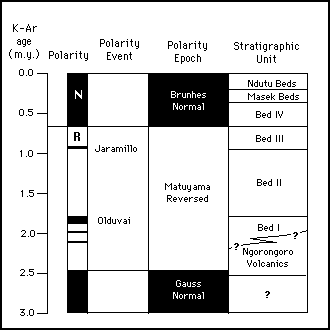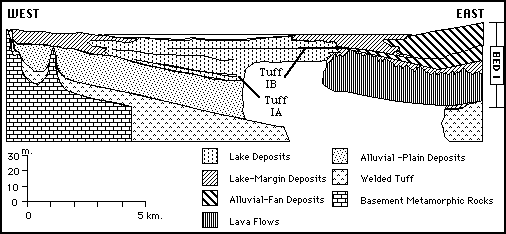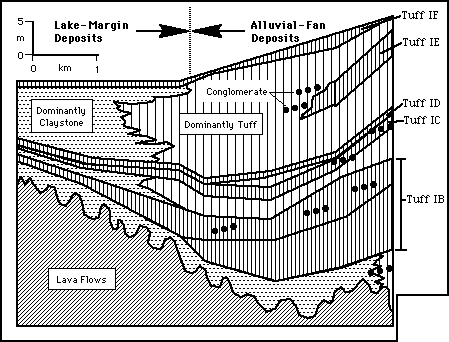Olduvai Formation 7 - General Chronology and Stratigraphy of
Olduvai Gorge
Now that you have familiarized yourself with the general course of the
development of the Olduvai Gorge, we will introduce you to some more specific
aspects of the chronology and stratigraphy.
The following cards contain diagrams and generalized profiles of the Olduvai
Gorge stratigraphy. Where applicable, you may click on a stratum to see the
developmental stage that corresponds to that layer in the sequence you just
viewed. In addition, you may click on the symbols for the various stratigraphic
layers in order to see a pop-up field with more detailed information about the
stratum.
Although Olduvai contains archaeological materials covering most of the time
span from 3+ million years ago to very recent times, in this exercise we are
primarily interested in Bed I, which contains the oldest hominid fossils from
the area.
Chart of the Chronology and Stratigraphy
of Olduvai Gorge

This scale is calibrated to time in millions of years before present
based on assays of the potassium-argon content of volcanic tuffs. Review the
stack on dating techniques if the K-Ar method is not clear to you.
Polarity refers to whether the polarity of the Earth's magnetic
fields was Normal compared to today, or Reversed. Periods of Normal Polarity
are marked in solid black. Periods of Reversed Polarity are white.
Polarity Event simply refers to named episodes of deviations in
the Earth's magnetic polarity in relation to the general polarity trend for that
epoch.
A Polarity Epoch is simply the name given to a period of time
with a well defined long-term trend in the polarity of the Earth's magnetic
field. We are currently in the Brunhes Normal Epoch.
Stratigraphic Unit refers to the names given to broadly
categorized groups of geological strata that are in a clear chronological
relationship to each other.
General Stratigraphy of Bed I at Olduvai Gorge

-
Lake Deposits
- The lake deposits consist of fine-grained clays and mudstones deposited at
the bottom of the large lake that formed in the basin sometime during the
developmental history of Bed I, and continued into the period when Bed IV was
formed, at which point it completely dried up. The Lake Deposits are
interbedded with lava and alluvial fan deposits on the east due to recurrent
changes in the extent of the lake. The interbedding with the alluvial plain
deposits on in the west is due to this same phenomenon.
Lake-Margin Deposits
- The Lake-Margin deposits are a complex group of clays, siltstones,
mudstones, and conglomerates derived from the constant ebb and flow of the
lake's edges and changes in the rate of erosion and deposition from the areas
surrounding the lake. It is the lake-margin deposits that have proven to be the
most productive in terms of the preservation of evidence of hominid activity.
Alluvial-Fan Deposits
- The Alluvial-Fan deposits are a complex of eroded, redeposited volcanic
tuffs, ashes, and mud-flows carried by stream action down from the volcanic
highlands to the south and east of the original gorge basin. These materials
eventually formed a huge alluvial fan spreading out from the highlands and down
to into the original basin, displacing the lake by several miles. A number of
the tuff strata are quite distinct, and have proven useful for dating the
stratigraphic sequence in the area using the Potassium-Argon method. Tuffs Ia
and Ib are the lowest strata for which reliable K-Ar dates have been obtained.
Lava Flows
- The lava flows exposed along the eastern portion of the gorge underlay, and
are considered a part of Bed I. These flows appear to derive from a period of
very intense volcanic activity sometime prior to about 2 million years ago. The
majority of the flows came from the Olmoti volcano, directly east of the gorge.
In the southern portion of the original basin, the lava flows probably came from
a vent on the side of the Ngorongoro volcano, although the vent has yet to be
located. There is some indication that the lava flows initially displaced the
eastern lake margin, but were then covered by the lake later as the water level
rose.
Alluvial-Plain Deposits
- The Alluvial-Plain deposits are derived from sediments brought down into
the basin from the south and west by stream activity during the period prior to
and after the formation of the lake. They interfinger with the lake deposits on
the western end of the gorge.
- Welded Tuff
- The Welded tuff strata all probably derive from massive eruptions of the
Ngorongoro volcano sometime during the early part of the Cenozoic era. On the
west the tuff has been called the Naabi Ignumbrite, and is clearly
contemporaneous with similar deposits found further south at Laetoli. The tuff
on the eastern end of the gorge has a slightly different chemical composition,
and so cannot definitely be assigned to the Naabi, but they did derive from the
same volcano, possibly as the result of an earlier eruption.
Basement Metamorphic Rocks
- The Basement Metamorphic rocks constitute the lowest known member of the
stratigraphic units at Olduvai. These rocks consist of gneisses and quartzites
of Precambrian age that have been folded and warped by the tectonic displacement
of the Afro-Arabian craton, of which they are a part.
Detail of the Gross Lake-Margin
Stratigraphy




